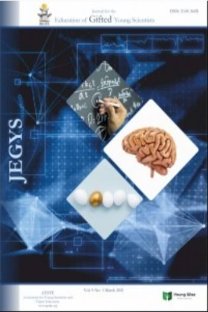Multiple Intelligences and Perfectionism in Middle School Gifted Students
In this study, the perfectionism levels of 181 sixth, seventh, and eighth grade gifted students’ were investigated in terms of multiple intelligences. In the study a relational screening model, Survey of Positive and Negative Perfectionism, developed by Kırdök (2004), was used to assess the level of the students’ positive and negative perfectionism. The Multiple Intelligences Inventory, developed by Saban (2001), was used to determine the students’ multiple intelligences, and a personal information form was implemented to obtain socio-demographic data. The results of the study showed that [verbal-linguistic intelligence, mathematical-logical intelligence, and intrapersonal intelligence] [intrapersonal intelligence, mathematical-logical intelligence, and verbal-linguistic intelligence] predicted 34% of the students’ perfectionism levels (p<.001). The explanatory power of the scores in multiple intelligences over negative perfectionism was not found to be statistically significant for any of the sub-dimensions. In order to develop gifted students’ positive perfectionism qualifications, assuming that multiple intelligences can be used as a tool, some suggestions were presented for researchers, counselors, and teachers.
Keywords:
gifted students multiple intelligences, perfectionism,
___
- Adderholdt, M., & Goldberg, J. (1999). Perfectionism: Whats bad about being too good. Minneapolis: Free Spirit Publishing.
- Akarsu, F. (2004). Üstün yetenekliler [Gifted child]. I. Türkiye Üstün Yetenekli Çocuklar Kongresi Seçilmiş Makaleler Kitabı, İstanbul: Çocuk Vakfı Yayınları, 142-146.
- Baker, J. A. (1996). Everyday stressors of academically gifted adolescents. Prufrock Journal, 7(2), 356-368.
- Bencik, S. (2006). Üstün yetenekli çocuklarda mükemmeliyetçilik ve benlik algısı arasındaki ilişkinin incelenmesi [Study of Relationship between Perfectionism and Self-concept in Gifted Children]. Unpublished Master’s Thesis, Hacettepe University.
- Bowers, E. (2012). The Everything Guide to Coping with Perfectionism: Overcome Toxic Perfectionism, Learn to Embrace Your Mistakes, and Discover the Potential for Positive Change. Adams Media.
- Burka, J. B., & Yuen, L. M. (1983). Procrastination: Why you do it, what to do about it now. New York: Addison-Wessley.
- Burns, D. D. (1980). The perfectionist’s script for self-defeat. Psychology Today, 34–51.
- Bümen, N. T. (2005). Okulda çoklu zekâ kuramı [Multiple Intelligences in School]. Pegem A Yayıncılık.
- Coşar Ciğerci, Z. (2006). Üstün Yetenekli Olan Ve Olmayan Ergenlerde Benlik Saygısı, Başkalarının Algılaması Ve Psikolojik Belirtiler Arasındaki İlişkiler[the compaarison of gifted and nongifted adolescents in terms of self-esteem pyschological indications and perceiptions by the others]. Unpublished Master’s Thesis, Sakarya University.
- Çalık, B. & Birgili, B. (2013). Multiple Intelligence Theory for Gifted Education: Criticisms and Implications, Journal for the Education of the Young Scientist and Giftedness, 1(2), 1-12.
- Dağlıoğlu, H. E. (1995). İlkokul 2.-5. Sınıflara Devam Eden Çocuklar Arasından Üstün Yetenekli Olanların Belirlenmesi [Identification of Gifted Students in grades between 2 to 5]. Hacettepe Üniversitesi Sağlık Bilimleri Enstitüsü, Yayımlanmamış Yüksek Lisans Tezi.
- Davaslıgil, Ü., (2004). Durum Tespit Komisyonu Ön Raporu [Evaluation Snap Report]. "I. Türkiye Üstün Yetenekli Çocuklar Kongresi." İstanbul: Çocuk Vakfı Yayınları.
- Flett, G. L., & Hewitt, P. L. (2002). Perfectionism and maladjustment: An overview of theoretical, definitional, and treatment issues. In P. L. Hewitt & G. L. Flett (Eds.), Perfectionism. Washington, DC: American Psychological Association.
- Frost, R. O., Marten, P., Lahart, C., & Rosenblate, R. (1990). The dimensions of perfectionism. Cognitive Therapy and Research, 14, 449–468.
- Gardner, H. (1993). Multiple intelligences: The theory in practice. Basic books.
- Gürel, E., & Tat, M. (2010). Çoklu Zekâ Kuramı: Tekli Zekâ Anlayışından Çoklu Zekâ Yaklaşımına [Multiple Intelligence: From Unitary Approach to Multiple Approach]. Journal of International Social Research, 3(11).
- Hoerr, T. R. (1994). The Multiple Intelligence Approach to Giftedness.Contemporary Education, 66(1), 32-35.
- Karasar, N. (2009). Bilimsel Araştırma Yöntemi [Scientific Research Methods]. Ankara: Nobel Yayın Dağıtım.
- Kırdök, O. (2004). Olumlu ve olumsuz mukemmeliyetcilik olcegi gelistirme calismasi [Reliability and Validity Studies of Positive and Negative Perfectionism Scale]. Unpublished Master Thesis. Cukurova Universitesi Sosyal Bilimler Enstitusu, Adana.
- Kline, B. E., & Short, E. B. (1991). Changes in emotional resilience: Gifted adolescent females. Roeper Review, 13(3), 118-121.
- Kramer, H. J. (1987). Anxiety, perfectionism and attributions for failure in gifted and non-gifted junior high school students. UMI Dissertation Abstracts.
- Kök, B. (2012). Üstün zekâlı ve yetenekli öğrencilerde farklılaştırılmış geometri öğretiminin yaratıcılığa, uzamsal yeteneğe ve başarıya etkisi [The Effect of Differentıated Geometry Teaching on Gifted and Talented Students in view of Creatıvıty, Spatial Ability and Success]. Unpublished doctoral dissertation. İstanbul: İstanbul University, Institute of Social Sciences.
- LoCicero, K. A., & Ashby, J. S. (2000). Multidimensional perfectionism in middle school age gifted students: A comparison to peers from the general cohort.Roeper Review, 22(3), 182-185.
- Özden, Y. (2008). Öğrenme ve öğretme [Learning and teaching], Ankara: Pegem Akademi Yayınları.
- Roberts, S. M., & Lovett, S. B. (1994). Examining the “F” in gifted: Academically gifted adolescents' physiological and affective responses to scholastic failure. Journal for the Education of the Gifted, 17(3), 241-259.
- Saban, A. (2004). Çoklu zekâ teorisi ve eğitimi [Theory and Education of Multiple Intelligences]. Nobel dağıtım, 2001.
- Schuler, P. A. (1997). Characteristics and Perceptions of Perfectionism in Gifted Adolescents in a Rural School Environment, Unpublished Phd’s Thesis, University of Connecticut,
- Schuler, P. A. (2000). Perfectionism and gifted adolescents. Prufrock Journal,11(4), 183-196.
- Schuler. P. A. (2002) Perfectionism in Gifted Children Adolescent: Neihart, M. and N. A. f. G. Children, the Social and emotianal development of gifted children: what do we know?, Prufrocks Press (TX)
- Selçuk, Z., Kayılı, H., & Okut, L. (2002). Çoklu zeka uygulamaları [Application of Multiple Intelligences]. Nobel.
- Somov, P. (2010). Present perfect: a mindfulness approach to letting go of perfectionism and the need for control. New Harbinger Publications.
- Temiz, N. (2007). Çoklu Zeka Kuramı- Okulda Ve Sınıfta [Multiple Intelligences in School and Class], Ankara: Nobel Yayın dağıtım.
- Başlangıç: 2013
- Yayıncı: Genç Bilge Yayıncılık
Sayıdaki Diğer Makaleler
Süleyman KAHRAMAN, Şenay BULUT BEDÜK
Eda DEMİRHAN, Gülden KAYA UYANIK, Özlem CANAN GÜNGÖREN, Duygu GÜR ERDOĞAN
